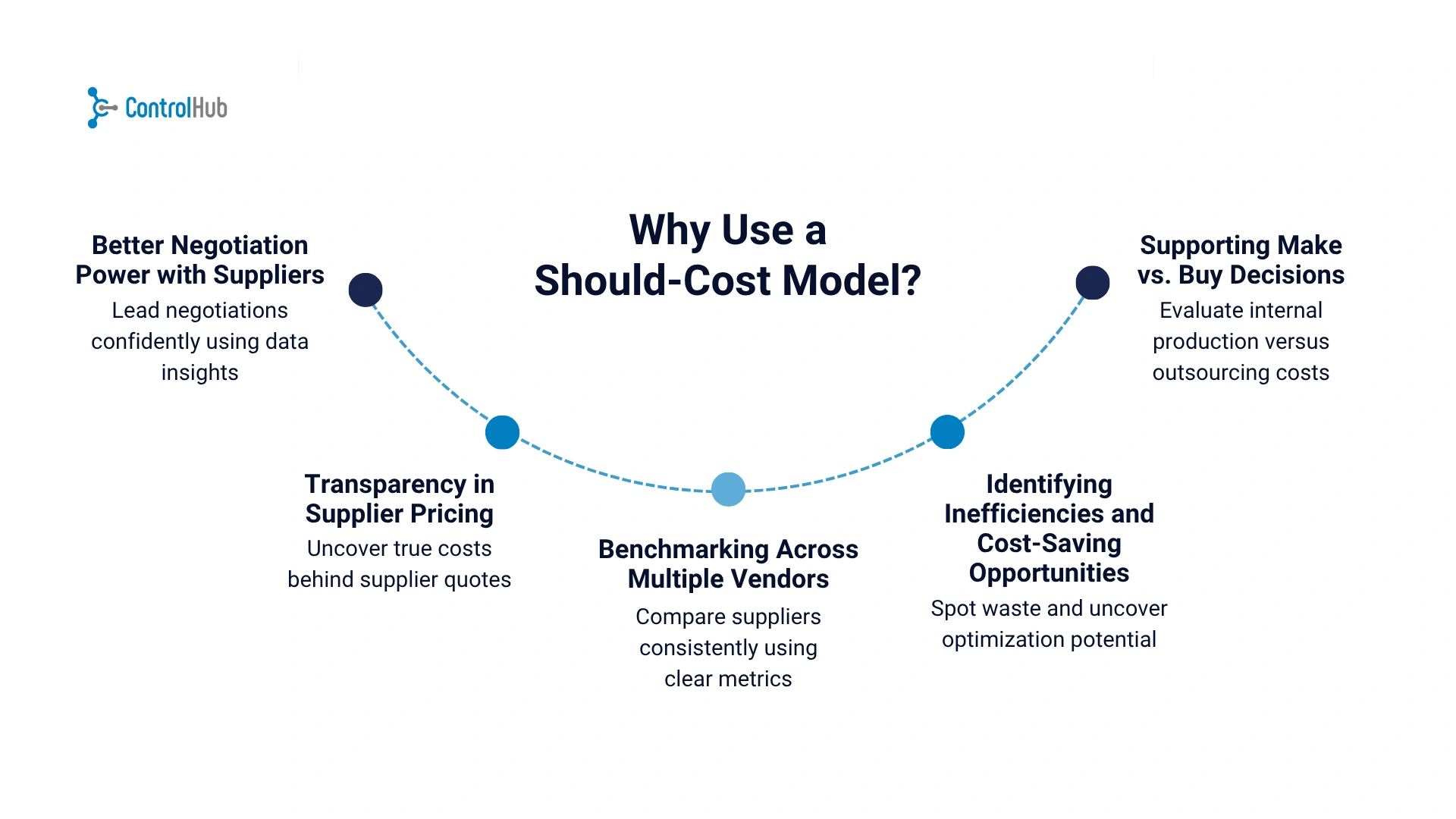Free Supplier Risk Scorecard Download
Download our free supplier risk scorecard here!
Download the free tool!AI Summarize:
What’s a Should Cost Model?
Think of it as the most effective way to discover how much you should pay for the goods and services your business needs.
Well, I just need to ask the supplier to know that…
Maybe, but how can you be sure that the pricing given by the supplier is a real reflection of the market?
A good cost model should be built from the ground up, based on real data.
With this, you don't need to wait to get a quote from a potential supplier to know if you're within budget.
That gives you the upper hand in negotiations, helps you spot inflated costs, and builds confidence in your decisions.
How It Works
A should cost model breaks down every cost element involved in making or delivering something. For example, if you’re sourcing a mechanical component, your model would factor in:
- The cost of raw materials (like steel or plastic)
- The labor hours required for assembly or machining
- The production process (equipment use, energy, maintenance)
- Packaging, shipping, and customs fees
- Overhead and reasonable supplier profit margins
Key Components of a Should Cost Model (300–350 words)
Want to understand what makes a should-cost model work?
Start by looking at its main components.
When you’re building a structure of costs, you’re trying to see what’s actually behind that number.
Here’s what usually makes up the backbone of a solid model:
Material Costs
No need to complicate things at this point, just start with the basics: what goes into the product.
Materials are usually the biggest cost.
You’ll want to look at current market rates for raw materials, sub-components, or even commodities if you’re dealing with metals or plastics. If prices are fluctuating, your model should reflect that.
Labor Costs
Okay, now it's time to move on to the next factor, the human side.
How much labor is involved in making or assembling the product?
Wages vary wildly by region, so it’s not just about how many hours you’ve spent, but where those hours are being paid.
Don’t forget indirect labor, like quality checks or packaging.
Manufacturing or Production Processes
This one’s about how the final product is made.
Every production method, whether it’s machining, injection molding, or manual assembly, comes with its own cost profile. Machine time, maintenance, and waste rates all matter here.
Logistics and Transportation
Getting the product from point A to point B isn’t free, and costs can add up fast. Think shipping fees, fuel prices, duties, and tariffs. Even packaging choices can swing your logistics costs up or down.
Overheads and Margins
Finally, don’t skip what suppliers add on top.
Overheads cover things like admin, rent, and utilities, basically what keeps their operation running. Then there’s profit margin.
Every supplier needs one, and understanding what’s reasonable gives you leverage when it’s time to negotiate.
When you put all these pieces together, you start to see the full story behind a supplier’s price.
And that’s exactly where the value of a should cost model kicks in; it helps you spot what’s fair, what’s inflated, and where you’ve got room to negotiate.
Free Supplier Risk Scorecard Download
Download our free supplier risk scorecard here!
Download the free tool!Why Use a Should-Cost Model?
Better Negotiation Power with Suppliers
When you walk into a negotiation armed with data, the conversation shifts. You’re not just reacting to a quote, you’re leading with insight. A should cost model lets you:
- Back up your arguments with real cost breakdowns (materials, labor, logistics, etc.)
- Identify exactly where a supplier might be overpricing.
- Ask informed, targeted questions instead of broad “Can you lower it?” ones.
- Build mutual trust by showing you understand their process and margins.
Transparency in Supplier Pricing
A should cost model peels back the layers of a quote. You’ll see what portion comes from materials, labor, overhead, and profit.
This clarity helps you spot inflated margins and recognize when a supplier’s pricing is actually fair.
Benchmarking Across Multiple Vendors
When comparing suppliers, it’s easy to get lost in different pricing structures.
The model brings consistency, helping you compare apples to apples. You’ll know who’s competitive and who’s stretching the numbers.
Identifying Inefficiencies and Cost-Saving Opportunities
By breaking down costs to the component level, you can pinpoint areas for optimization, whether that involves switching materials, changing production methods, or reevaluating logistics.
Supporting Make vs. Buy Decisions
Finally, should cost models provide the hard data you need for strategic decisions?.
You can evaluate whether it’s cheaper to produce internally or outsource, and that can reshape your entire sourcing strategy.
Free Supplier Risk Scorecard Download
Download our free supplier risk scorecard here!
Download the free tool!Steps to Build a Should-Cost Model
Step 1: Define the Scope
Start by deciding what exactly you’re analyzing. Is it a complete product, a single part, or maybe a recurring service?
The scope determines how deep you’ll go. The trick is to keep it focused enough to be practical but wide enough to give you useful insight.
A good rule of thumb is to start small, one product, one supplier, and scale from there once your approach is solid.
Step 2: Collect Data
This is where your inner investigator comes in. You’ll need to gather data on:
- Material prices: Current market or commodity rates.
- Labor costs: Regional averages or supplier benchmarks.
- Logistics: Shipping, customs, and handling fees.
- Overheads: General business expenses that influence total cost.
Use public databases, industry reports, and supplier quotes.
The goal isn’t perfection.
It’s to build a realistic starting point that reflects today’s market conditions.
Step 3: Break Down the Cost Drivers
Here’s where your model starts taking shape. Dissect the product or service into its main cost components so you can see what drives the price the most. Typical cost buckets include:
- Materials and components
- Labor and production time
- Machinery or process-related costs
- Packaging, logistics, and storage
- Overheads and supplier margins
Once you can see where the money flows, inefficiencies become much easier to spot.
Step 4: Use Benchmarks and Historical Data
Numbers mean more when you have something to compare them against.
Use previous purchase records, internal project data, or external benchmarks from your industry.
This step helps you understand whether your current supplier’s quote makes sense or if there’s room for improvement.
Step 5: Validate with Experts
Don’t build your model in isolation. Bring in engineering, operations, or finance experts to pressure-test your assumptions.
They’ll catch details you might miss, like machine downtime, waste rates, or quality control costs, that can change the picture entirely.
Step 6: Apply Scenario Analysis
Once your base model feels solid, play out some what-if situations.
- What if raw material prices rise or drop?
- How does the cost change if you shift production to another region?
- What happens at higher volumes or with process automation?
Scenario testing helps you stay prepared for market shifts and strengthens your negotiation position.
Best Practices for Should-Cost Models
Keep It Simple and Flexible
It’s tempting to pack your model with every possible variable, but complexity can kill usability in business settings.
Focus on what really moves the cost: materials, labor, logistics, and margins.
Start with a simple structure and add detail only when it genuinely improves accuracy.
The goal is to make it something people actually use, not a spreadsheet that nobody seems to understand.
Use Reliable and Current Data
Your model is only as good as the data behind it. Pull information from verified sources like industry reports, government labor indexes, or trusted market databases.
Prices for materials and logistics can shift fast, so make it a habit to refresh your data periodically, quarterly if possible.
Collaborate Across Teams
Cost modeling shouldn’t live solely in procurement. Involve engineering, finance, and operations teams early on.
They bring valuable context about design choices, manufacturing processes, and internal cost structures. This cross-functional input makes your model more realistic and helps align everyone on cost expectations.
Update and Refine Regularly
Things are never static, and right now it's a fact that markets evolve, and so should your model.
Review it often to adjust for inflation, supply chain shifts, or process changes. A model that’s kept current becomes a useful tool, not just a one-time analysis.
Focus on Relationships, Not Just Numbers
Want to make the most out of your negotiation?
Give some attention to the quality of relationships you're building with suppliers.
A should cost model isn’t a weapon to pressure suppliers; it’s a way to create transparency and collaboration.
Sharing insights can lead to joint cost-reduction initiatives and better partnerships.
Free Supplier Risk Scorecard Download
Download our free supplier risk scorecard here!
Download the free tool!Free Supplier Risk Scorecard Download
Download our free supplier risk scorecard here!
Download the free tool!Key Takeaways
A should cost model helps you understand what a product or service should cost based on real inputs—materials, labor, logistics, and overhead—not just supplier quotes.
It gives you leverage in negotiations, letting you challenge prices with data instead of assumptions.
The main components of any model include material costs, labor, manufacturing processes, logistics, and supplier margins.
Building one is a step-by-step process: define your scope, collect reliable data, break down cost drivers, benchmark, validate with experts, and test different scenarios.
When used well, it uncovers hidden inefficiencies and helps identify where savings or redesign opportunities exist.
It’s not just about cutting costs—it’s about creating transparency and collaboration between you and your suppliers.
The best results come from keeping your model simple, updated, and flexible, while using trustworthy data sources.
Cost models are powerful across industries—whether you’re comparing suppliers, making a make-vs-buy decision, or justifying budgets internally.
Ultimately, it’s a decision-making tool that builds confidence, clarity, and stronger supplier relationships.
%20(1).avif)



.webp)

.webp)











.png)


